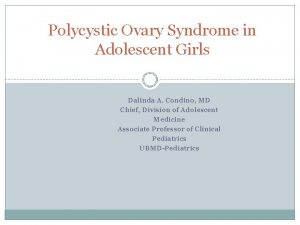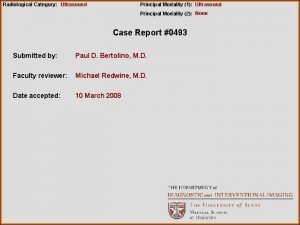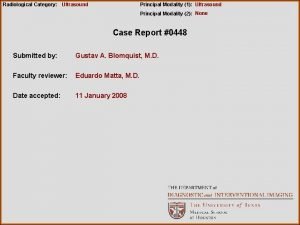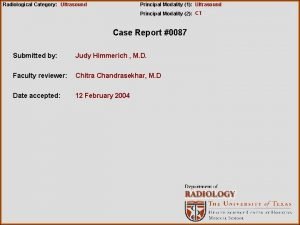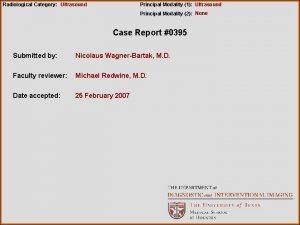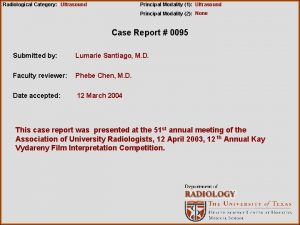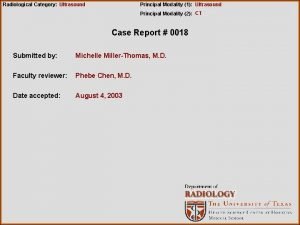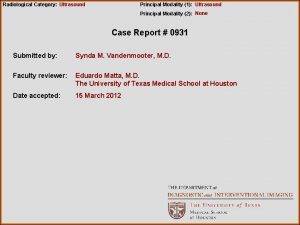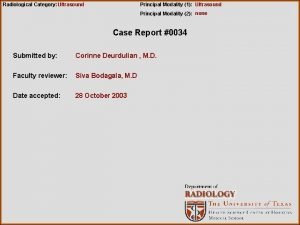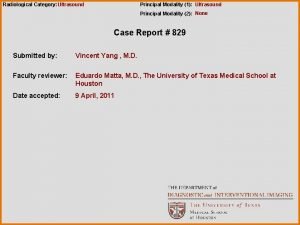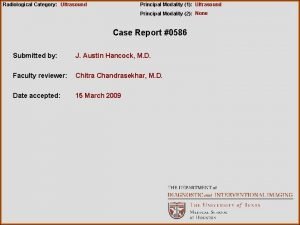Radiological Category Ultrasound Principal Modality 1 Ultrasound Principal














- Slides: 14

Radiological Category: Ultrasound Principal Modality (1): Ultrasound Principal Modality (2): CT and MRI Case Report #0613 Submitted by: Megan Jenkins, M. D. Faculty reviewer: Anuradha Rao, M. D. Date accepted: 14 April 2009

Case History 39 year old female with two-week history of rapidly growing neck mass

Radiological Presentations LONG RT THYROID

Radiological Presentations TRANS RIGHT THYROID

Radiological Presentations CONTRAST ENHANCED CT – AXIAL, CORONAL, SAGITTAL

Test Your Diagnosis Which one of the following is your choice for the appropriate diagnosis? After your selection, go to next page. • Follicular Thyroid Cancer • Papillary Thyroid Cancer • Lymphoma • Metastases

Radiological Presentations T 1 WEIGHTED MR T 2 WEIGHTED MR

Findings and Differentials Findings: Ultrasound demonstrates a large, lobulated complex solid and cystic hyperechoic mass within the right thyroid lobe with marked intrinsic vascularity, punctate areas of calcification, and papillary projections. The lesion is surrounded by a cystic cavity. CT Neck Soft Tissues demonstrates an enlarged right thyroid lobe with a well circumscribed, heterogeneous mass with both cystic and solid components. Punctate calcifications are present within the solid component. The lesion appears to exert a degree of mass effect on the airway and displaces the carotid artery and jugular vein posterolaterally. MR images of the neck demonstrate a right neck mass with solid central component that is isointense on T 1 and hypointense on T 2. The surrounding cystic component demonstrates mild hyperintensity on T 1 and marked hyperintensity on T 2 indicating the presence of acute versus subacute blood products.

Findings and Differentials: • Papillary Thyroid Cancer, Cystic Variant • Follicular Thyroid CA • Metastasis • Lymphoma

Discussion Papillary thyroid cancer accounts for roughly 50 -75% of all thyroid malignancies. It generally carries a good prognosis since it usually remains intrathyroidal and metastatasize via the lymphatic locally to involve regional lymph nodes alone. The incidence is highest in females with a 2. 5 to 4: 1 predominance with most patients affected in the 4 th to 6 th decades. Papillary tumors of the thyroid are the most common form of thyroid cancer to result from exposure to radiation. Five year survival rate is 95 -99%. Ultrasonographic appearance of papillary thryoid carcinoma is variable, but often presents as a hypoechoic nodule with punctate internal calcifications representing psammoma bodies that are highly indicative of malignancy. Cystic areas with hemorrhage and necrosis are uncommon. A cystic component of papillary carcinoma occurs in 12 -25% of all thyroid malignancies but a predominant cystic appearance is uncommon. Though it may be mistake for cystic change in a hyperplastic nodule, careful US assessment will demonstrate solid components with vascularity, solid excrescences protruding into the cyst, or microcalcifications, which will help differentiate a papillary carcinoma from a benign cystic hyperplastic nodule. Cystic degeneration is a common finding with nodal metastases but rarely has been found to involve the primary tumor. Additionally, the majority of cystic thyroid nodules are benign degenerating autonomously functioning thyroid adenomas.

Discussion Follicular thyroid carcinoma is a slow growing malignancy with characteristic invasion into the blood vessels and hematogenous spread to the lung and bone. Cystic areas with hemorrhage and necrosis are common. Spread to regional lymph nodes is uncommon. Five year survival rate is roughly 65%. Peak incidence is seen in women aged 40 -60 years old. Alternatively, lymphoma accounts for roughly 4% of thyroid malignancies and is characteristically the sequela of long-standing Hashimoto’s Thyroiditis with lymphocytic infiltration of the gland. Although metastatic disease to the thyroid gland is rare, the most common primary malignancies to metastasize are malignant melanoma, breast, lung, and kidney.

Discussion Gross pathologic examination revealed a 4. 0 cm thyroid mass with dark red and granular surface. Multiple sub centimeter nodules were identified with focal areas of hemorrhage and necrosis. Low and medium power histologic slides above demonstrate extracapsular extension of the tumor with invasion into the surrounding skeletal muscle, a common early finding with papillary thyroid CA.

Diagnosis Papillary Thyroid Cancer, Cystic Variant

References Chan BK, Desser TS, et al. Common and uncommon sonographic features of papillary thyroid carcinoma. J Ultrasound Med 2003; 22(10): 1083– 1090. Hatabu H, Kassagi K, Yammamoto K, Lida Y, Misaki T, Hidoka A, Shibata T, Shoji K, Highuchi K: Cystic papillary carcinoma of the thyroid: A new sonographic sign. Clin Radiol 1991; 43: 121 -124 Hoang, J. Lee, W. et al. US Features of Thyroid Malignancy: Pearls and Pitfalls. Radiographics. May-June 2007; 27 (3): 847 -60. King AD, Ahuja AT, To EW, Tse GM, Metreweli C. Staging papillary carcinoma of the thyroid: magnetic resonance imaging vs ultrasound of the neck. Clinical Radiology 2000; 55: 222 -226 Som PM, Brandwein M, Lidov M, Lawson W, Biller HF. The varied presentations of papillary thyroid carcinoma cervical nodal disease: CT and MR findings. AJNR 1994; 15: 1123 -1128
 Ferriman–gallwey score
Ferriman–gallwey score Erate category 2 eligible equipment
Erate category 2 eligible equipment Center for devices and radiological health
Center for devices and radiological health National radiological emergency preparedness conference
National radiological emergency preparedness conference Radiological dispersal device
Radiological dispersal device Tennessee division of radiological health
Tennessee division of radiological health High modality examples
High modality examples Pacs modality workstation
Pacs modality workstation Short wave diathermy definition
Short wave diathermy definition Characteristics of sensory neurons
Characteristics of sensory neurons Sodality vs modality
Sodality vs modality Epistemic modality
Epistemic modality Cardinality and modality
Cardinality and modality Cardinality and modality
Cardinality and modality Cardinality and modality
Cardinality and modality
